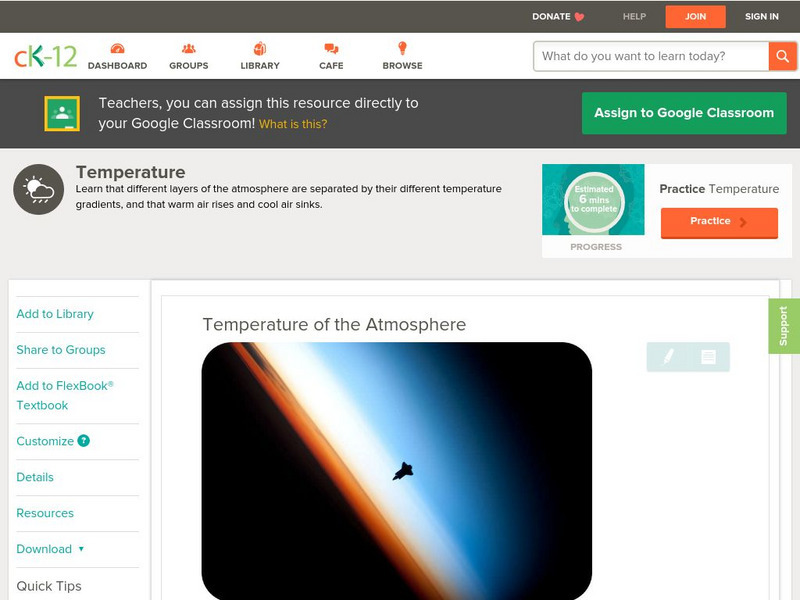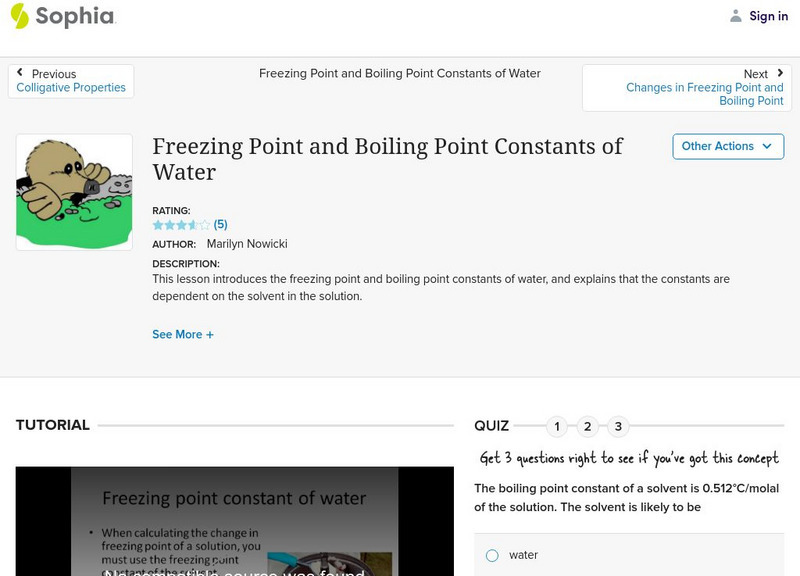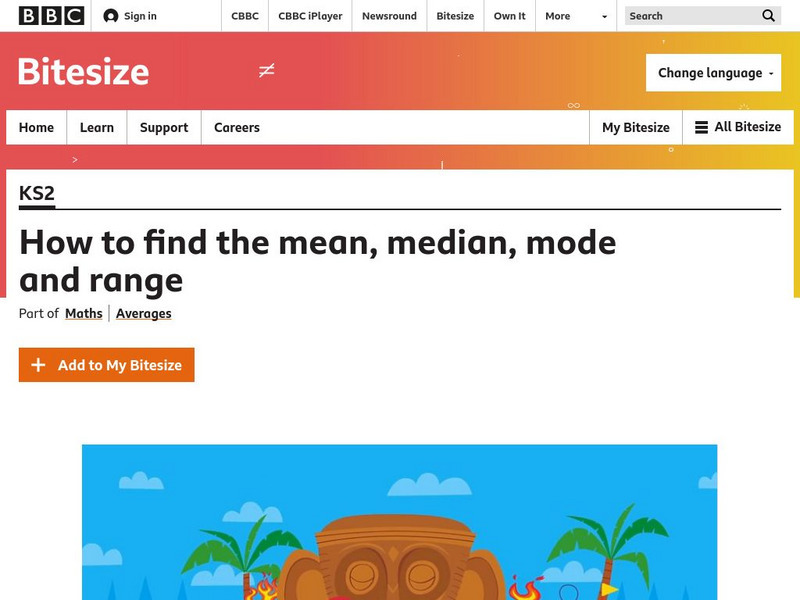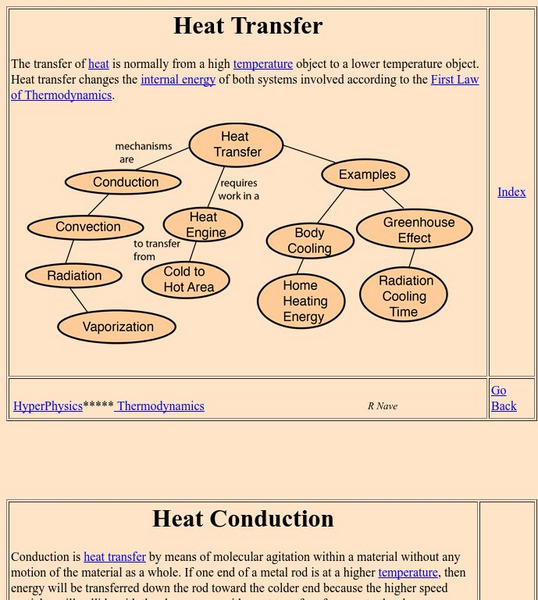TeachEngineering
Teach Engineering: How Hot Is It?
Students learn about the nature of thermal energy, temperature and how materials store thermal energy. They discuss the difference between conduction, convection and radiation of thermal energy, and complete activities in which they...
CK-12 Foundation
Ck 12: Earth Science: Heat Budget of Planet Earth
[Free Registration/Login may be required to access all resource tools.] The balance of heat entering and exiting Earth's atmosphere.
CK-12 Foundation
Ck 12: Earth Science: Introduction to Weather
[Free Registration/Login may be required to access all resource tools.] Covers the definition of weather and the factors that make up weather.
Utah Education Network
Uen: Heat Sources Feeling Hot Hot Hot!
How does temperature vary in the sunshine and shade. Find out as you participate in this lab activity. The resource also has some online thermometers for you to read.
Chem Tutor
Chem Tutor: Chemistry: States of Matter
This lesson focuses on the states of matter: solids, liquids, and gases. It also discusses the Kinetic Theory of Matter, Thermodynamics, Triple point, Phase Change Graphs and the Heating Curve of Water. It provideds adrawing of a heating...
Texas Education Agency
Texas Gateway: Celsius 4 1 1: All About Thermal Energy
A 5E activity exploring thermal energy. TEKS (11)(A).
Math Is Fun
Math Is Fun: Conversion of Temperature: Celsius to Fahrenheit
Learn about the two main temperature scales, Celsius and Fahrenheit, and how to convert temperature from one to another. View two conversion examples and a chart of typical temperatures, and use the conversion tool.
CK-12 Foundation
Ck 12: Earth Science: Temperature of the Atmosphere
[Free Registration/Login may be required to access all resource tools.] How different temperature gradients separate the atmosphere into distinct layers.
CK-12 Foundation
Ck 12: Plix Series: Charles' Law: Gas Balloon
[Free Registration/Login Required] Observe what happens to the volume of a balloon with a change in temperature. After the activity, answer a multiple-choice, challenge question.
CK-12 Foundation
Ck 12: Plix Series: Gay Lussac's Law
[Free Registration/Login Required] Increase the heat in the virtual container, and observe what happens to the internal pressure.
CK-12 Foundation
Ck 12: Plix Series: Temperature Transition: Linear Equations
[Free Registration/Login Required] Use the linear equation graph to convert temperatures from Celsius to Fahrenheit. After the activity, answer the challenge question to check for understanding.
CK-12 Foundation
Ck 12: Physical Science: Amontons' Law
[Free Registration/Login may be required to access all resource tools.] Amontons' law and the relationship between the temperature and pressure of a gas.
Utah Education Network
Uen: Weather Walks
In this multi-day, learners will learn weather through multisensory approaches. Students will make daily predictions. After each daily prediction, they will collect measurement and observational data by taking walks in different types of...
Sophia Learning
Sophia: Freezing Point and Boiling Point Constants of Water
This video tutorial reviews the freezing point and boiling point constants of water. [1:19]
University of Cambridge
University of Cambridge: Nrich: Game Do You Measure Up?
This interactive game gives you a variety of measuring tools and measuring opportunity. For this game of chance you choose the correct tool for the job that needs to be measured. Everything you need for this game is listed and/or...
BBC
Bbc Schools: Ks2 Bitesize: Science: Materials: Heat
A short, illustrated tutorial about how heat energy moves. After reading the material, take a quick quiz to check for understanding.
BBC
Bbc Revise Wise Maths: Mode, Median, Mean
This website from the BBC is a great introduction to averages (mean, median, and mode) and will take you through some interactive learning activities. A practice test and worksheet are also provided.
American Geosciences Institute
American Geosciences Institute: Wind Classroom Activities
When air is warmed, it expands and becomes less dense. As the air becomes less dense, its air pressure decreases. This occurs because molecules in warm air have greater kinetic energy (energy of motion) than in cold air. As the molecules...
Other
All math.com: Us/metric Conversion Tables
Convert metric measurements to U.S. Measurements and the reverse, too. Easy to follow tables have sections for area, length, mass,temperature and volume.
Sophia Learning
Sophia: Factors Affecting Reaction Rate
This lesson will describe the factors affecting reaction rate, including temperature, stirring (agitation), surface area (particle size), concentration.
Georgia State University
Georgia State University: Hyper Physics: Heat Convection
Using understandable words and exceptional graphics, this page describes the transfer of energy by means of the convection process. Contains several links to related topics.
Georgia State University
Georgia State University: Hyper Physics: Heat Pump
Heat flow from a hot region to a cold region is described and explained. Applications of this phenomenon (specifically heat pumps and refrigerators) are discussed. Excellent graphics.
Georgia State University
Georgia State University: Hyper Physics: Entropy
This informative site is from Georgia State University. The tendency of nature to move towards a more disordered state in an isolated system, a concept known as entropy, is discussed. This concept is well-depicted in meaningful diagrams.
Georgia State University
Georgia State University: Hyper Physics: Heat of Fusion
The heat of fusion is defined and described. A graphical representation of the heat of vaporization is given. A method for measuring and calculating the heat of fusion is also presented and explained.

























